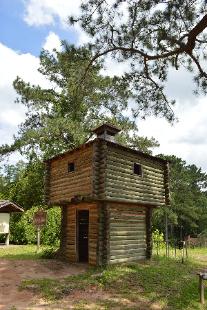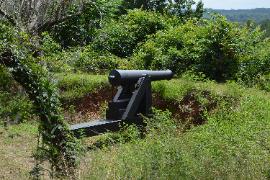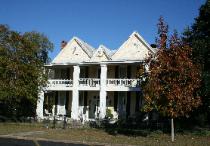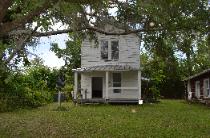Fort Gaines, Georgia - Historic Sites & Points of Interest
Fort Gaines, Georgia - Historic Sites & Points of Interest
Fort Gaines, Georgia
A restored blockhouse marks the site
of the frontier stockade built in 1816
by U.S. troops. It stands high atop a
bluff overlooking the Chattahoochee
River.
A restored blockhouse marks the site
of the frontier stockade built in 1816
by U.S. troops. It stands high atop a
bluff overlooking the Chattahoochee
River.
The Dill House at Fort Gaines
Elizabeth Stewart Dill lived here with
her husband John Dill. She was the
sole female survivor of the Scott
Massacre of 1817.
Elizabeth Stewart Dill lived here with
her husband John Dill. She was the
sole female survivor of the Scott
Massacre of 1817.
| Cannon at Fort Gaines, Georgia A cannon still aims out at the Chattahoochee River from a Civil War emplacement at Fort Gaines. |
200 years of Georgia history
Fort Gaines has marked the passage of time
in Southwest Georgia for more than 200
years.
The community was founded as a frontier fort
in the spring of 1815. It is a remarkable place
of antebellum and Victorian homes, historic
sites and pioneer cemeteries.
The fort was built as a result of the Treaty of
Fort Jackson, an agreement signed in
August 1814 between the Creek Nation and
the United States. It transferred 24,000,000
acres of Native American land to the United
States as compensation for the losses
suffered by its citizens during the Creek War
of 1813-1814.
The cession included all of the Creek territory
that bordered Spanish Florida. The mouth of
Cemochechobee Creek marked the point
where the new southern border of the nation
crossed the Chattahoochee River and U.S.
authorities quickly decided that a fort should
be built there as a demonstration of the
government's power.
The task fell to the men of Clinch's battalion
of the 4th U.S. Infantry. They traveled down
the river from Fort Mitchell in the spring of
1815. Maj. Gen. Edmund P. Gaines and Lt.
Col. Duncan Lamont Clinch selected a site
for the new fort atop a high bluff just below
the mouth of the Cemochechobee.
The original fort was rectangular, with log
walls and blockhouses at two diagonal
corners. It was named in honor of Gen.
Gaines, the commander of the expedition
and a noted hero of the War of 1812.
Three different forts would stand here over
the next 50 years.
Fort Gaines was an important base for
operations down the river the U.S. military's
campaign against the Fort at Prospect Bluff
(or "Negro Fort" in Florida. It was also an
important defensive point and supply depot
during the First Seminole War of 1817-1818.
The second fort was built in 1836 when
Creek warriors destroyed the nearby town of
Roanoke, Georgia, and launched the Creek
War of 1836. Settlers from the area flooded
into the hastily constructed fortification but the
war ended quickly and the works were
dismantled.
The last of the three forts was built by
Confedeate forces during the War Between
the States (Civil War). It featured
emplacements for three heavy cannon, a
magazine and connecting trenches.
Designed to protect the upriver industrial city
of Columbus from attack by Union gunboats,
the fort never came under attack but its
remains and one of the original cannon can
still be seen.
The city of Fort Gaines began to grow even
before the first fort was abandoned.
Settlers flooded into the treaty lands. Farms
and later plantations grew in a time when
cotton was king. People and cargoes came
and went on paddlewheel steamboats and
Fort Gaines became a prosperous place.
The antebellum era crashed to an end in
1861 with the outbreak of war between the
South and the North. Union warships
blockaded the mouth of the river system and
commerce came to a halt.
There was great fear that Union gunboats
could invade the Deep South via the
Apalachicola and Chattahoochee Rivers so
the Confederate army ordered the
construction of a series of forts and batteries
along the waterway.
The northernmost of these was at Fort
Gaines, which also played an important role
in the treatment of the desperately wounded
soldiers of that war. Hospitals were
established in the town and patients arrived
by rail and water.
A number did not survive and were buried in
the city's New Park Cemetery. Local legend
tells that they were badly wounded in the
Battle of Olustee, Florida.
in Southwest Georgia for more than 200
years.
The community was founded as a frontier fort
in the spring of 1815. It is a remarkable place
of antebellum and Victorian homes, historic
sites and pioneer cemeteries.
The fort was built as a result of the Treaty of
Fort Jackson, an agreement signed in
August 1814 between the Creek Nation and
the United States. It transferred 24,000,000
acres of Native American land to the United
States as compensation for the losses
suffered by its citizens during the Creek War
of 1813-1814.
The cession included all of the Creek territory
that bordered Spanish Florida. The mouth of
Cemochechobee Creek marked the point
where the new southern border of the nation
crossed the Chattahoochee River and U.S.
authorities quickly decided that a fort should
be built there as a demonstration of the
government's power.
The task fell to the men of Clinch's battalion
of the 4th U.S. Infantry. They traveled down
the river from Fort Mitchell in the spring of
1815. Maj. Gen. Edmund P. Gaines and Lt.
Col. Duncan Lamont Clinch selected a site
for the new fort atop a high bluff just below
the mouth of the Cemochechobee.
The original fort was rectangular, with log
walls and blockhouses at two diagonal
corners. It was named in honor of Gen.
Gaines, the commander of the expedition
and a noted hero of the War of 1812.
Three different forts would stand here over
the next 50 years.
Fort Gaines was an important base for
operations down the river the U.S. military's
campaign against the Fort at Prospect Bluff
(or "Negro Fort" in Florida. It was also an
important defensive point and supply depot
during the First Seminole War of 1817-1818.
The second fort was built in 1836 when
Creek warriors destroyed the nearby town of
Roanoke, Georgia, and launched the Creek
War of 1836. Settlers from the area flooded
into the hastily constructed fortification but the
war ended quickly and the works were
dismantled.
The last of the three forts was built by
Confedeate forces during the War Between
the States (Civil War). It featured
emplacements for three heavy cannon, a
magazine and connecting trenches.
Designed to protect the upriver industrial city
of Columbus from attack by Union gunboats,
the fort never came under attack but its
remains and one of the original cannon can
still be seen.
The city of Fort Gaines began to grow even
before the first fort was abandoned.
Settlers flooded into the treaty lands. Farms
and later plantations grew in a time when
cotton was king. People and cargoes came
and went on paddlewheel steamboats and
Fort Gaines became a prosperous place.
The antebellum era crashed to an end in
1861 with the outbreak of war between the
South and the North. Union warships
blockaded the mouth of the river system and
commerce came to a halt.
There was great fear that Union gunboats
could invade the Deep South via the
Apalachicola and Chattahoochee Rivers so
the Confederate army ordered the
construction of a series of forts and batteries
along the waterway.
The northernmost of these was at Fort
Gaines, which also played an important role
in the treatment of the desperately wounded
soldiers of that war. Hospitals were
established in the town and patients arrived
by rail and water.
A number did not survive and were buried in
the city's New Park Cemetery. Local legend
tells that they were badly wounded in the
Battle of Olustee, Florida.
The economy of the community rebounded
after the end of the war and continued to
thrive for as long as the river remained a
major avenue for commerce. The business
booms finally slowed, however, and Fort
Gaines has became a quiet and beautiful
community of historic homes and ancient
landmarks.
You won't spend long in the city before you
begin to hear stories of two of its most
prominent early residents, Elizabeth and
John Dill.
Elizabeth Stewart Dill was captured by Creek
and Seminole Warriors on November 30,
1817, at the Scott Massacre near present-day
Chattahoochee, Florida. She spent six
months in captivity before being freed by
troops under Maj. Gen. Andrew Jackson.
A popular local legend holds that Mrs.
Stewart who married John Dill after the death
of her first husband, made the most of her
difficult experience by collecting paper money
thrown away by Native American warriors
when they returned from their raids against
the Georgia frontier. She used this haul of
cash to build a new life for herself when she
settled in Fort Gaines after the end of the
First Seminole War.
The Dills are buried at the town's historic
Pioneer Cemetery. Many of the area's other
early residents are buried there as well,
including the second president of the
University of Georgia.
Fort Gaines today is a small city of around
1,100 residents. It is a gateway to beautiful
Lake Walter F. George (Lake Eufaula) and is
home to the George T. Bagby State Park &
Lodge. The park features hundreds of acres
of rolling landscape along the shores of the
lake and offers cottages, lodge rooms, a
restaurant, marina and much more.
The town is also home to the amazing
Sutton's Corner Frontier Country Store
Museum. Originally located in the nearby
countryside, the museum preserves a store
that operated from the 1840s until the 1920s.
It contains one of the most remarkable
collections of rural store artifacts in the world.
Fort Gaines is a charming destination with a
rich history and a promising future. It is a
great place anytime but can be especially fun
during the annual Christmas at the Fort Arts
and Crafts Festival. Thousands of people
flood to the bluff for this annual holiday
festival which is held each year on the
Saturday before Thanksgiving from 9 a.m. - 3
p.m. (Eastern).
Please click here to learn more about Fort
Gaines and Clay County, Georgia.
after the end of the war and continued to
thrive for as long as the river remained a
major avenue for commerce. The business
booms finally slowed, however, and Fort
Gaines has became a quiet and beautiful
community of historic homes and ancient
landmarks.
You won't spend long in the city before you
begin to hear stories of two of its most
prominent early residents, Elizabeth and
John Dill.
Elizabeth Stewart Dill was captured by Creek
and Seminole Warriors on November 30,
1817, at the Scott Massacre near present-day
Chattahoochee, Florida. She spent six
months in captivity before being freed by
troops under Maj. Gen. Andrew Jackson.
A popular local legend holds that Mrs.
Stewart who married John Dill after the death
of her first husband, made the most of her
difficult experience by collecting paper money
thrown away by Native American warriors
when they returned from their raids against
the Georgia frontier. She used this haul of
cash to build a new life for herself when she
settled in Fort Gaines after the end of the
First Seminole War.
The Dills are buried at the town's historic
Pioneer Cemetery. Many of the area's other
early residents are buried there as well,
including the second president of the
University of Georgia.
Fort Gaines today is a small city of around
1,100 residents. It is a gateway to beautiful
Lake Walter F. George (Lake Eufaula) and is
home to the George T. Bagby State Park &
Lodge. The park features hundreds of acres
of rolling landscape along the shores of the
lake and offers cottages, lodge rooms, a
restaurant, marina and much more.
The town is also home to the amazing
Sutton's Corner Frontier Country Store
Museum. Originally located in the nearby
countryside, the museum preserves a store
that operated from the 1840s until the 1920s.
It contains one of the most remarkable
collections of rural store artifacts in the world.
Fort Gaines is a charming destination with a
rich history and a promising future. It is a
great place anytime but can be especially fun
during the annual Christmas at the Fort Arts
and Crafts Festival. Thousands of people
flood to the bluff for this annual holiday
festival which is held each year on the
Saturday before Thanksgiving from 9 a.m. - 3
p.m. (Eastern).
Please click here to learn more about Fort
Gaines and Clay County, Georgia.
The Toll House
This structure was built in the 1820s
and was once owned by John Dill. He
served as a major general of Georgia
militia during the Creek War of 1836.
This structure was built in the 1820s
and was once owned by John Dill. He
served as a major general of Georgia
militia during the Creek War of 1836.
Sutton's Corner Museum
The remarkable Sutton's Corner
Frontier Country Store Museum has
been called "one of a kind" by U.S.
museum professionals.
The remarkable Sutton's Corner
Frontier Country Store Museum has
been called "one of a kind" by U.S.
museum professionals.
Burials of Two Civilizations
The gazebo at New Park Cemetery in
Fort Gaines stands atop a Native
American burial mound that is more
than 1,000 years old.
The gazebo at New Park Cemetery in
Fort Gaines stands atop a Native
American burial mound that is more
than 1,000 years old.
The Forts of Fort Gaines
The Remarkable Story of Elizabeth Dill
Historic Cemeteries of Fort Gaines
Online Tour of Fort Gaines, Georgia
Kolomoki Mounds State Park
Eufaula, Alabama
Historic Sites & Points of Interest
Historic Sites in Georgia
Explore other Southern Historic Sites
The Remarkable Story of Elizabeth Dill
Historic Cemeteries of Fort Gaines
Online Tour of Fort Gaines, Georgia
Kolomoki Mounds State Park
Eufaula, Alabama
Historic Sites & Points of Interest
Historic Sites in Georgia
Explore other Southern Historic Sites
Coheelee Creek Covered Bridge
Providence Canyon State Park
Battle of Roanoke (Roanoke Massacre)
Battle of Shepherd's Plantation
Andersonville National Historic Site
Flint RiverQuarium in Albany
Fort Early Monument & Historic Site
Radium Springs Gardens & Historic Site
Bridge House & Riverfront Park in Albany
Providence Canyon State Park
Battle of Roanoke (Roanoke Massacre)
Battle of Shepherd's Plantation
Andersonville National Historic Site
Flint RiverQuarium in Albany
Fort Early Monument & Historic Site
Radium Springs Gardens & Historic Site
Bridge House & Riverfront Park in Albany

Custom Search
| Copyright 2017 by Dale Cox All rights reserved. Last Updated: August 31, 2017 (Some contents 2011) |
Southwest Georgia Historic Sites
FORT GAINES, GEORGIA
Historic Sites & Points of Interest
Historic Sites & Points of Interest






